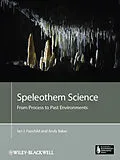Speleothems (mineral deposits that formed in caves) are currently giving us some of the most exciting insights into environments and climates during the Pleistocene ice ages and the subsequent Holocene rise of civilizations. The book applies system science to Quaternary environments in a new and rigorous way and gives holistic explanations the relations between the properties of speleothems and the climatic and cave setting in which they are found. It is designed as the ideal companion to someone embarking on speleothem research and, since the underlying science is very broad, it will also be invaluable to a wide variety of others. Students and professional scientists interested in carbonate rocks, karst hydrogeology, climatology, aqueous geochemistry, carbonate geochemistry and the calibration of climatic proxies will find up-to-date reviews of these topics here. The book will also be valuable to Quaternary scientists who, up to now, have lacked a thorough overview of these important archives. Additional resources for this book can be found at: href="http://www.wiley.com/go/fairchild/speleothem">www.wiley.com/go/fairchild/speleothem.
Autorentext
Ian Fairchild was originally a geologist, then more
specifically a sedimentologist, morphing into a physical geographer
with leanings to environmental chemistry, before putting more
geology back in the mix. Hence, he is now Professor of
Geosystems at the University of Birmingham, UK, researching both on
modern environments and interpreting those in deep time, with
carbonates, waters and climates as linking themes.
Andy Baker was trained as a physical geographer, and
worked at the interface of geology, physical geography, and
environmental engineering. He is currently a Professor at
the University of New South Wales and a chief investigator in
Australia's National Centre for Groundwater Research and
Training.
Inhalt
Preface, xi
Acknowledgements, xiii
I Scientifi c and geological context, 1
1 Introduction to speleothems and systems, 3
1.1 What is all the fuss about?, 3
1.2 How is this book organized?, 11
1.3 Concepts and approaches of system science, 13
1.4 The speleothem factory within the karst system, 18
2 Carbonate and karst cave geology, 28
2.1 Carbonates in the Earth system over geological time, 28
2.2 Lithologies of carbonate host rocks, 34
2.3 Carbonate diagenesis and eogenetic karst, 47
2.4 Speleogenesis in mesogenetic and telogenetic karst (withcontributions from John Gunn and David J Lowe), 55
2.5 Cave infilling, 64
2.6 Conclusion, 71
3 Surface environments: climate, soil and vegetation,73
3.1 The modern climate system, 73
3.2 Water isotopes in the atmosphere, 84
3.3 Soils of karst regions, 94
3.4 Vegetation of karst regions, 102
3.5 Synthesis: inputs to the incubator, 104
II Transfer processes in karst, 105
4 The speleothem incubator, 107
4.1 Introduction to speleophysiology, 107
4.2 Physical parameters and fl uid behaviour, 109
4.3 Water movement, 114
4.4 Air circulation, 122
4.5 Heat flux (authored by David Domínguez-Villar), 137
4.6 Synthesis: cave climatologies, 145
5 Inorganic water chemistry, 148
5.1 Sampling protocols for water chemistry, 148
5.2 The carbonate system, 152
5.3 Weathering, trace elements and isotopes, 156
5.4 Carbon isotopes, 173
5.5 Evolution of cave water chemistry: modelling sources andenvironmental signals, 180
6 Biogeochemistry of karstic environments, 187
6.1 Introduction, 187
6.2 Organic macromolecules, 188
6.3 Pollen and spores, 198
6.4 Cave faunal remains, 199
6.5 Synthesis and research gaps, 200
III Speleothem properties, 205
7 The architecture of speleothems, 207
7.1 Introduction, 207
7.2 Theoretical models of stalagmite growth and of stalagmiteand stalactite shapes, 207
7.3 Geometrical classifi cation of speleothems, 213
7.4 Mineralogy and petrology, 223
7.5 Synthesis, 241
8 Geochemistry of speleothems, 245
8.1 Analysis and the sources of uncertainty, 245
8.2 The growth interface, 249
8.3 Trace element partitioning, 255
8.4 Oxygen and carbon isotope fractionation, 263
8.5 Evolution of dripwater and speleothem chemistry along waterflowlines, 277
8.6 Process models of variability over time, 281
9 Dating of speleothems, 290
9.1 Introduction, 290
9.2 Dating techniques, 291
9.3 Age-distance models, 300
9.4 Conclusions, 301
IV Palaeoenvironments, 303
10 The instrumental era: calibration and validation ofproxy-environment relationships, 305
10.1 Available instrumental and derived series, 306
10.2 Methodologies, 311
10.3 Case studies of calibrated speleothem proxies, 316
10.4 Questions raised and future directions, 323
11 The Holocene epoch: testing the climate and environmentalproxies, 324
11.1 A brief overview of the Holocene, 325
11.2 The past millennium, 327
11.3 Holocene environmental changes: speleothem responses,334
11.4 Questions raised and future directions, 351
12 The Pleistocene and beyond, 353
12.1 Pleistocene proxy records (ice-age climate fl uctuationsdefined and drawn), 353
12.2 Insights into pre-Quaternary palaeoenvironments, 361
12.3 Questions raised and looking to the future, 365
APPENDIX 1 Archiving speleothems and speleothem data,368
References, 371
Index, 421
